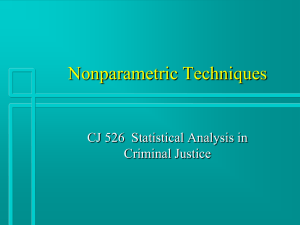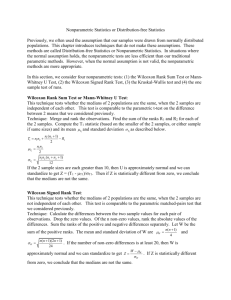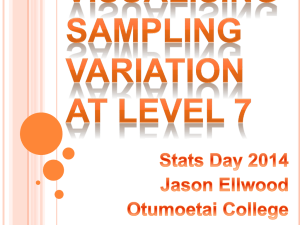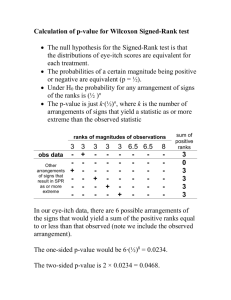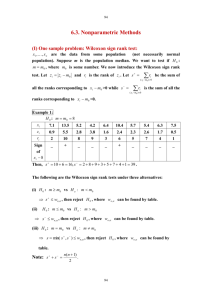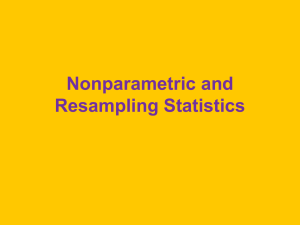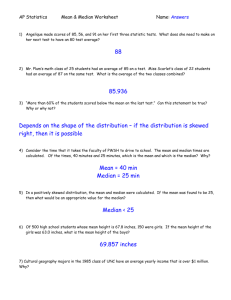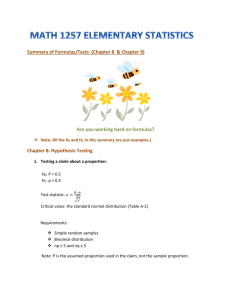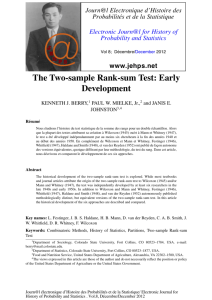Summary of Formulas/Tests (Chapter 13 Nonparametric Statistics)
advertisement
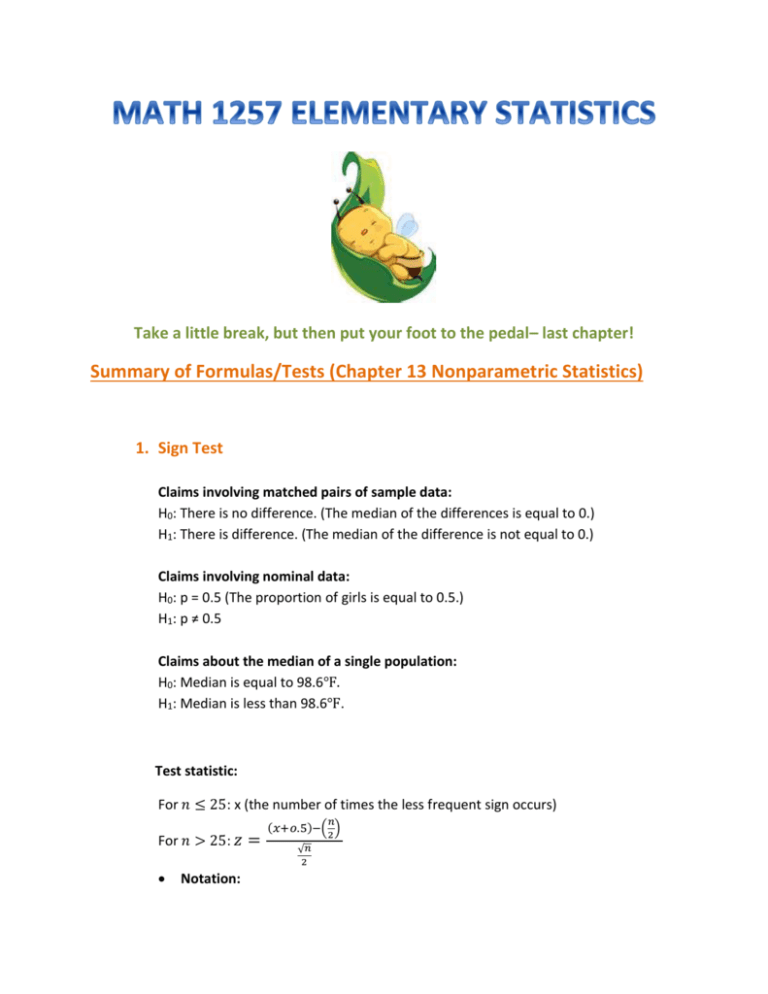
Take a little break, but then put your foot to the pedal– last chapter! Summary of Formulas/Tests (Chapter 13 Nonparametric Statistics) 1. Sign Test Claims involving matched pairs of sample data: H0: There is no difference. (The median of the differences is equal to 0.) H1: There is difference. (The median of the difference is not equal to 0.) Claims involving nominal data: H0: p = 0.5 (The proportion of girls is equal to 0.5.) H1: p ≠ 0.5 Claims about the median of a single population: H0: Median is equal to 98.6℉. H1: Median is less than 98.6℉. Test statistic: For 𝑛 ≤ 25: x (the number of times the less frequent sign occurs) For 𝑛 > 25: 𝑧 = Notation: 𝑛 2 (𝑥+𝑜.5)−( ) √𝑛 2 X: the number of times the less frequent sign occurs n: the total number of positive and negative signs combined Critical values: For 𝑛 ≤ 25: critical x values are found in Table A-7 For 𝑛 > 25: critical z values are found in Table A-2. Requirements: 1. The sample data have been randomly selected. 2. There is no requirement that the sample data come from a population with a particular distribution, such as a normal distribution. 2. Wilcoxon Signed-Ranks Test for Matched Pairs H0: The matched pairs have differences that come from a population with a median equal to zero. H1: The matched pairs have differences that come from a population with a nonzero median. Test statistic: 1. If 𝑛 ≤ 30, the test statistic is T. 2. If 𝑛 > 30, the test statistic is 𝑧 𝑇− = √ 𝑛(𝑛+1) 4 𝑛(𝑛+1)(2𝑛+1) 24 Notation: T: the smaller of the following two sums: 1. The sum of the absolute values of the negative ranks of the nonzero differences d 2. The sum of the positive ranks of the nonzero differences d Critical values: n is the number of pairs of data for which the difference d is not 0. If 𝑛 ≤ 30, the critical T value is found in Table A-8. (Note: Reject the null hypothesis if the test statistic T is less than or equal to the critical value found in A-8). If 𝑛 > 30, the critical z values are found in Table A-2. Requirements: 1. The data consist of matched pairs that have been randomly selected. 2. The population of differences (found from the pairs of data) has a distribution that is approximately symmetric. (There is no requirement that the data have a normal distribution.) Note: Sign Test vs. Wilcoxon Signed-Ranks Test for Matched Pairs Both sign test and Wilcoxon signed-ranks test are nonparametric tests. Sign Test uses plus and minus signs to test different claims, including: claims involving matched pairs of sample data, claims involving nominal data and claims about the median of a single population. The Wilcoxon signed-Ranks test uses ranks of sample data consisting of matched pairs. It is used to test null hypothesis that the population of differences has a median of zero. The sign test can also be used with matched pairs, but the sign test uses only the signs of the differences. By using ranks, the Wilcoxon signed-ranks test takes the magnitudes of the differences into account. Because the Wilcoxon signed-ranks test incorporates and uses more information than the sign test, it tends to yield conclusions that better reflect the true nature of the data. 3. Wilcoxon Rank-Sum Test for two independent samples H0: The two samples come from populations with equal medians. H1: The two samples come from populations with different medians. Test statistic: 𝑛1 (𝑛1 + 𝑛2 + 1) 𝜇𝑅 = 2 𝑛1 𝑛2 (𝑛1 + 𝑛2 + 1) 𝜎𝑅 = √ 12 𝑧= 𝑅 − 𝜇𝑅 𝜎𝑅 Critical values: Critical values can be found in Table A-2. Notation: 𝑛1 : size of sample 1 𝑛2 : size of sample 2 𝑅1 : sum of ranks for sample 1 𝑅2 : sum of ranks for sample 2 𝑅: same as 𝑅1 𝜇𝑅 : mean of the sample R values that are expected when the two populations have equal medians 𝜎𝑟 : standard deviation of the sample R values that is expected with two populations having equal medians Requirements: 1. There are two independent samples of randomly selected data. 2. Each of the two samples has more than 10 values. 3. There is no requirement that the two populations have a normal distribution or any other particular distribution. 4. Kruskal-Wallis Test H0: The samples come from populations with equal medians. H1: The samples come from populations with medians that are not all equal. Test statistic: 12 𝑅12 𝑅22 𝑅𝑘2 𝐻= ( + + ⋯ + ) − 3(𝑁 + 1) 𝑁(𝑁 + 1) 𝑛1 𝑛2 𝑛𝑘 Critical Values: df = k – 1 where k is the number of different samples. Use Table A-4. Notation: N: total number of observations in all samples combined K: number of samples 𝑅1 : sum of ranks for sample 1 𝑛1 : number of observations in sample 1 Requirements: 1. We have at least three independent samples, all of which are randomly selected. 2. Each sample has at least five observations. 3. There is no requirement that the populations have a normal distribution or any other particular distribution. Note: Both Wilcoxon Rank-Sum Test and Kruskal-Wallis Test need to temporarily combine all samples into one big sample and assign a rank to each sample value. 5. Rank correlation H0: 𝜌𝑠 = 0 (no correlation) H1: 𝜌𝑠 ≠ 0 (correlation) Test statistic: Not ties: 𝑟𝑠 = 1 − Ties: 𝑟𝑠 = 6 ∑ 𝑑² 𝑛(𝑛2 −1) 𝑛 ∑ 𝑥𝑦−(∑ 𝑥)(∑ 𝑦) √𝑛(∑ 𝑥²)−(∑ 𝑥)²√𝑛(∑ 𝑦²)−(∑ 𝑦)² Critical values: 1. If 𝑛 ≤ 30, critical values are found in Table A-9. 2. If 𝑛 > 30, critical values are found by using formula 𝑟𝑠 = ±𝑧 √𝑛−1 where z corresponds to the significance level. Notation: 𝑟𝑠 : rank correlation coefficient for sample paired data 𝜌𝑠 : rank correlation coefficient for all the population data 𝑛: number of pairs of sample data 𝑑: difference between ranks for the two values within a pair Requirements: 1. The sample paired data have been randomly selected. 2. There is no requirement that the sample pairs of data have a bivariate normal distribution. There is no requirement of a normal distribution for any population.
